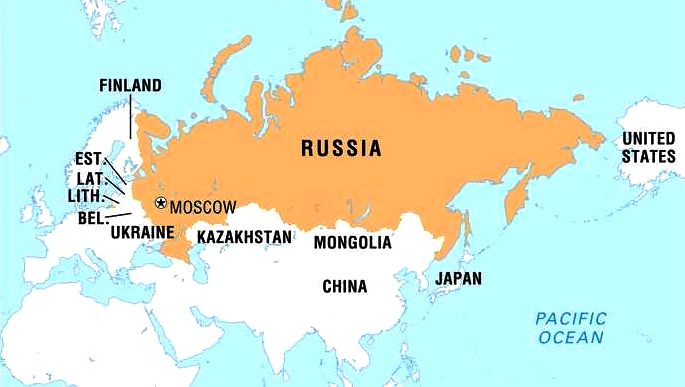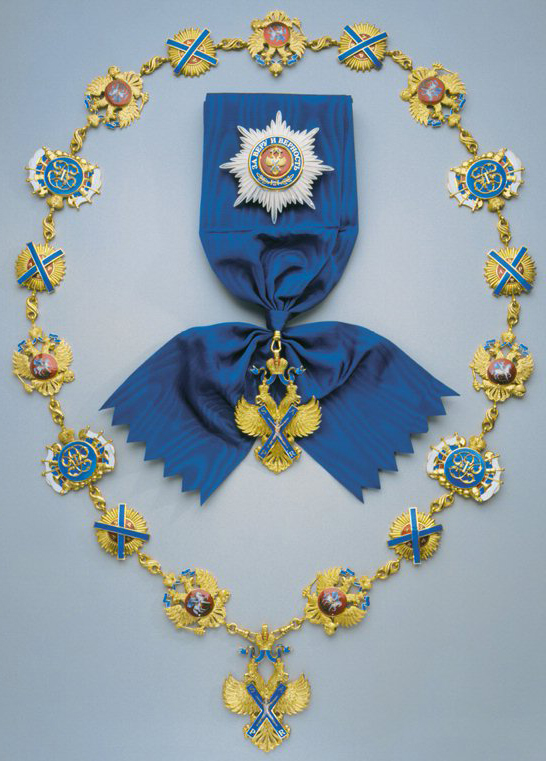22nd India-Russia Annual Summit | 10 Jul 2024
For Prelims: Order of Saint Andrew the Apostle, Programme-2030, Make in India, Chennai-Vladivostok Eastern Maritime Corridor, International Solar Alliance, Gross National Income, World Bank, Atmanirbhar Bharat, International North-South Transport Corridor
For Mains: Significance of India- Russia Relations, International Cooperation and Multilateral Forums
Why in News?
The 22nd India-Russia Annual Summit in Moscow, brought together Prime Minister Narendra Modi and President Vladimir Putin to discuss a wide range of issues. The summit aimed to solidify the strategic partnership between the two nations, particularly in light of the ongoing geopolitical tensions.
What are the Key Highlights of the 22nd India-Russia Annual Summit?
- Diplomatic Achievements: President Vladimir Putin conferred Russia's highest civilian honour, the "Order of Saint Andrew the Apostle," on Prime Minister Narendra Modi.
- The Order of Saint Andrew the Apostle was established by Tsar Peter the Great in 1698 and reinstated in 1998, featuring a double-headed eagle emblem and a light blue silk moire ribbon.
- The award is named after Saint Andrew, the patron saint of Russia and Scotland, known for spreading Christianity across Europe and Asia.
- Prime Minister Modi was honoured with this award for promoting the strategic partnership and friendly relations between Russia and India, and the announcement was made in 2019, highlighting Modi’s pivotal role in enhancing bilateral cooperation
- Foreign leaders such as Chinese President Xi Jinping and former Kazakh President Nursultan Nazarbayev have also been honoured with this award.
- The Order of Saint Andrew the Apostle was established by Tsar Peter the Great in 1698 and reinstated in 1998, featuring a double-headed eagle emblem and a light blue silk moire ribbon.
- Economic Cooperation: A new bilateral trade target of USD 100 billion by 2030 was set, significantly higher than the previous target of USD 30 billion by 2025, which was nearly doubled in 2023.
- This is mainly due to India's increased imports of Russian crude at a discount after the US and Europe imposed oil sanctions on Russia following the invasion of Ukraine.
- Agreement to prepare a comprehensive "Programme-2030" for developing promising areas of economic cooperation.
- This program will be coordinated by the India-Russia Intergovernmental Commission on Trade, Economic, Scientific, Technical and Cultural Cooperation (IRIGC-TEC).
- IRIGC-TEC is the apex G2G forum for bilateral economic cooperation, chaired by the External Affairs Minister of India and the Deputy Prime Minister of Russia.
- This program will be coordinated by the India-Russia Intergovernmental Commission on Trade, Economic, Scientific, Technical and Cultural Cooperation (IRIGC-TEC).
- India and the Eurasian Economic Union have commenced negotiations for a Free Trade Agreement on goods. They also plan to explore a bilateral free-trade agreement in services and investments.
- The Leaders agreed to facilitate participation of Russian businesses in "Make in India" and "Atmanirbhar Bharat" programs, and Indian companies in investment projects in Russia.
- Defence and Technology: Transition from buyer-seller relationship to joint research, development, co-development, and joint production of advanced defence technology and systems.
- They also aim to encourage joint manufacturing of spare parts and components for Russian-origin arms and defence equipment in India under the Make-in-India program.
- This includes setting up joint ventures for meeting the needs of the Indian Armed Forces and for subsequent export to friendly third countries.
- They have agreed to establish a new Working Group on Technological Cooperation to discuss its provisions in the next meeting of Intergovernmental Commission on Military and Military Technical Cooperation (IRIGC-M&MTC).
- Russian President Vladimir Putin has accepted the Prime Minister of India’s request to discharge Indian military recruits serving in the Russian military on the Ukrainian war front and wishing to return to India.
- Russian law allows the recruitment of foreign soldiers after thorough screening, including mental and physical checks.
- The summit ended without the signing of the long-awaited Reciprocal Exchange of Logistics Agreement (RELOS). The agreement would have provided logistical support for military operations between Russia and India.
- The Indian Navy would have benefited the most from the agreement, gaining access to Russian military facilities in the Arctic.
- They also aim to encourage joint manufacturing of spare parts and components for Russian-origin arms and defence equipment in India under the Make-in-India program.
- Transport and Connectivity: The Sides are focused on developing stable and efficient transport corridors in Eurasia, including the Chennai-Vladivostok Eastern Maritime Corridor and the International North-South Transport Corridor (INSTC).
- The Chennai-Vladivostok Maritime Corridor, is a sea link between ports on the east coast of India and ports in the far-east region of Russia was proposed in 2019 and it aims to transport various types of cargo and reduce the transportation time to Russia by 40%.
- The INSTC is a multi-modal transportation route established in 2000 in St. Petersburg by Iran, Russia, and India to promote transportation cooperation among member states.
- The corridor connects the Indian Ocean and the Persian Gulf to the Caspian Sea via Iran, and then is connected to St. Petersburg and Northern Europe via the Russian Federation.
- They aim to increase infrastructure capacity and use the potential of the Northern Sea Route. Both Sides will work together to reduce time and cost of cargo transportation and promote connectivity in the Eurasian space.
- International Cooperation: Russia appreciated India’s non-permanent membership in the UN Security Council (2021-22) and supported India’s efforts in peacekeeping and counter-terrorism.
- Russia reiterated its support for India's permanent membership in a reformed and expanded UN Security Council.
- India expressed full support for Russia's BRICS Chairship in 2024 under the theme "Strengthening Multilateralism for Just Global Development and Security."
- Close cooperation in international forums such as the UN, G20, BRICS, and Shanghai Cooperation Organization (SCO) is emphasised to reinvigorate multilateralism.
- The Indian side looked forward to Russia's joining of the International Solar Alliance (ISA), the Coalition for Disaster Resilient Infrastructure (CDRI), and the International Big Cat Alliance (IBCA).
- Global Issues:
-
Climate Change: Commitment to combating climate change and achieving the goals of the United Nations Framework Convention on Climate Change (UNFCCC) and the Paris Agreement, including cooperation on low-carbon development and green financing.
-
Multipolar World Order: Emphasis on the need for a multipolar world order and the development of an architecture of equal and indivisible regional security in the Eurasian space and the Indian and Pacific ocean regions.
-
Counter Terrorism: The leaders unequivocally condemned terrorism and violent extremism in all its forms and manifestations, including the cross-border movement of terrorists and terrorism financing networks.
- The sides reaffirmed their commitment to strengthening multilateral cooperation in combating transnational organised crime, money laundering, terrorist financing, and drug trafficking.
-
Note:
In another development Russia has reached a significant economic milestone by being upgraded from an upper-middle-income to a high-income country by the World Bank, despite ongoing Western sanctions.
What Factors Contributed to Russia’s Status as a High-Income Country?
- Economic Growth Across Sectors: The World Bank classifies countries based on their Gross National Income (GNI) per capita, expressed in US dollars using the Atlas method (accounting for purchasing power parity).
- As of July 2024, the threshold for "high-income" is USD 14,005. Russia crossed this threshold in 2023 with a GNI per capita of USD 14,250.
- Russia saw notable growth in trade (+6.8%), the financial sector (+8.7%), and construction (+6.6%) in recent years, boosting both real (3.6%) and nominal (10.9%) GDP.
- Impact of Military Spending: A substantial increase in military-related activities in 2023 bolstered economic activity, though experts suggest this growth may not be sustainable.
- Trade Diversification: Western sanctions led to a shift in trade patterns, reducing dependence on G7 and EU countries and increasing transactions with China, India, Türkiye, Central Asia, and the South Caucasus.
- Resilient Energy Sector: Despite sanctions on its energy sector, Russia maintained steady overall export volumes, leveraging global oil prices and strategic trade diversification.
- Fiscal Stimulus and Investment: Government initiatives, including fiscal stimulus and increased defence spending (estimated at 7% of GDP), supported economic recovery and growth.
- Job Market and Consumer Spending: Low unemployment, rising wages, and strong private consumption contributed positively to economic stability and growth.
- Overcoming earlier sanctions from 2014, Russia adapted its economic policies and infrastructure investments to mitigate ongoing challenges.
What is the World Bank's Country Income Classification?
- About: The World Bank Group assigns the world's economies to four income groups: low, lower-middle, upper-middle, and high.
- The classifications are updated annually on 1st July based on the GNI per capita of the previous calendar year.
- The World Bank's income classification aims to reflect a country's level of development, using Atlas GNI per capita as an indicator of economic capacity.
- Classification Thresholds:
- Low-income: USD 1,145 or less;
- Lower-middle-income: USD 1,146 to USD 4,515;
- Upper-middle-income: USD 4,516 to USD 14,005;
- High-income: More than USD 14,005.
- Factors such as economic growth, inflation, exchange rates, and population growth can influence a country's GNI per capita.
- Regional Highlights:
-
In South Asia, the share of low-income countries has fallen from 100% in 1987 to just 13% in 2023.
- According to the World Bank, India is a lower-middle income country. India has been in this category since 2007, when it moved up from the low-income category.
- As of 2023, India’s GNI per capita in terms of PPP is approximately USD 10,030.
- According to the World Bank, India is a lower-middle income country. India has been in this category since 2007, when it moved up from the low-income category.
- In the Middle East and North Africa, the share of low-income countries has increased from 0% in 1987 to 10% in 2023.
- In Latin America and the Caribbean, the share of high-income countries has climbed from 9% in 1987 to 44% in 2023.
-
Europe and Central Asia have a slightly lower share of high-income countries in 2023 (69%) than it did in 1987 (71%).
-
- Note: GNI measures the total domestic and foreign value added claimed by residents at a given period, usually a year, expressed in international dollars using purchasing power parity rates.
- It includes GDP plus net receipts of primary income from nonresident sources and provides an aggregate measure of income.
Conclusion
The 22nd India-Russia Annual Summit underscored the robust strategic partnership between the two nations, marked by significant diplomatic honours, ambitious economic targets. Despite global geopolitical challenges, both countries reaffirmed their commitment to enhancing bilateral ties across various sectors. The summit's outcomes reflect a shared vision for regional stability, economic growth, and mutual respect on the global stage, reinforcing the enduring nature of the Indo-Russian relationship amidst evolving international dynamics.
|
Drishti Mains Question: Q. How have recent geopolitical shifts, such as the rise of multipolarity and increasing global strategic competition, influenced the strategic partnership between India and Russia? |
UPSC Civil Services Examination Previous Year Question (PYQ)
Prelims
Q. Recently, India signed a deal known as ‘Action Plan for Prioritization and Implementation of Cooperation Areas in the Nuclear Field’ with which of the following countries? (2019)
(a) Japan
(b) Russia
(c) The United Kingdom
(d) The United States of America
Ans: B
Mains
Q. What is the significance of Indo-US defence deals over Indo-Russian defence deals? Discuss with reference to stability in the Indo-Pacific region. (2020)


